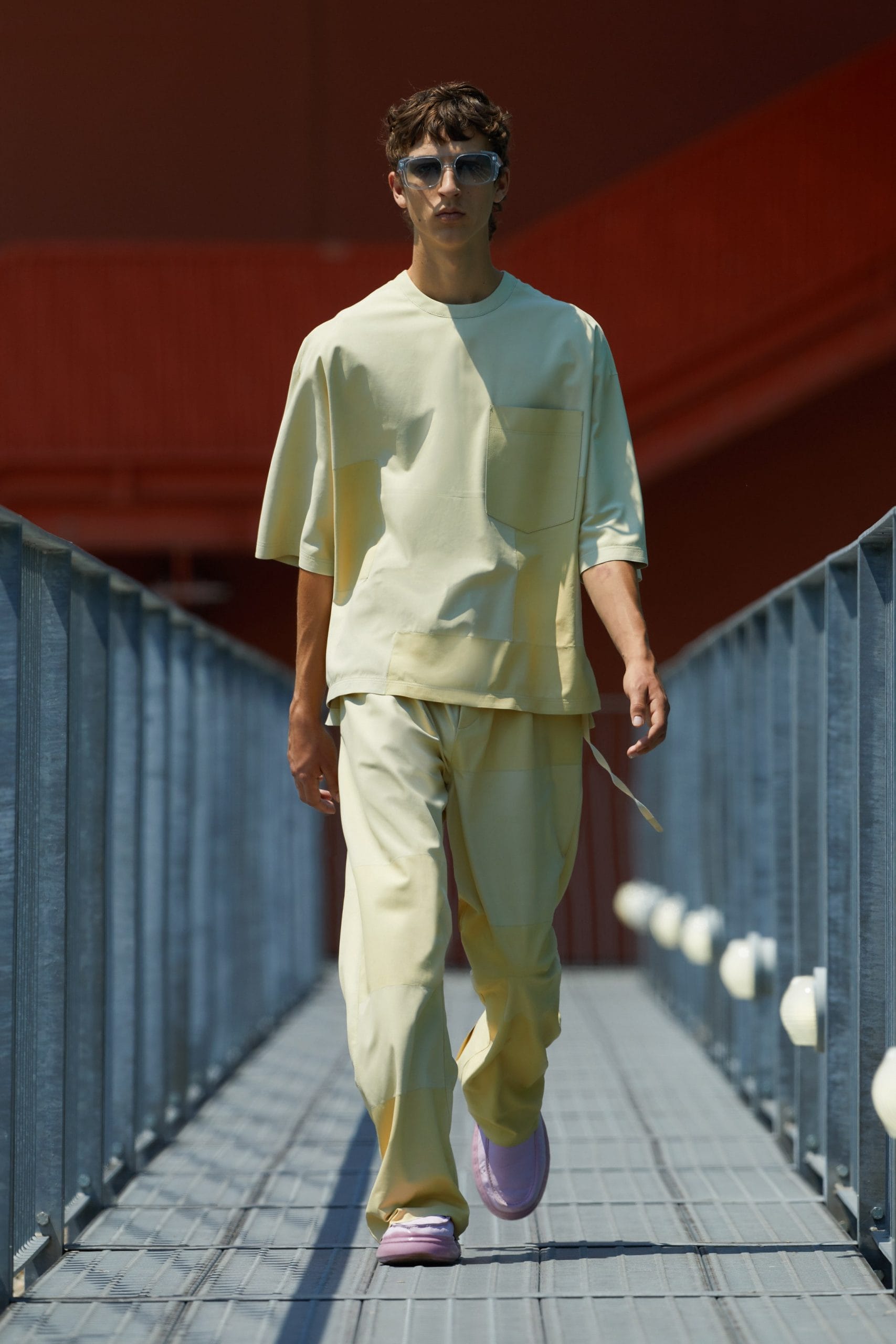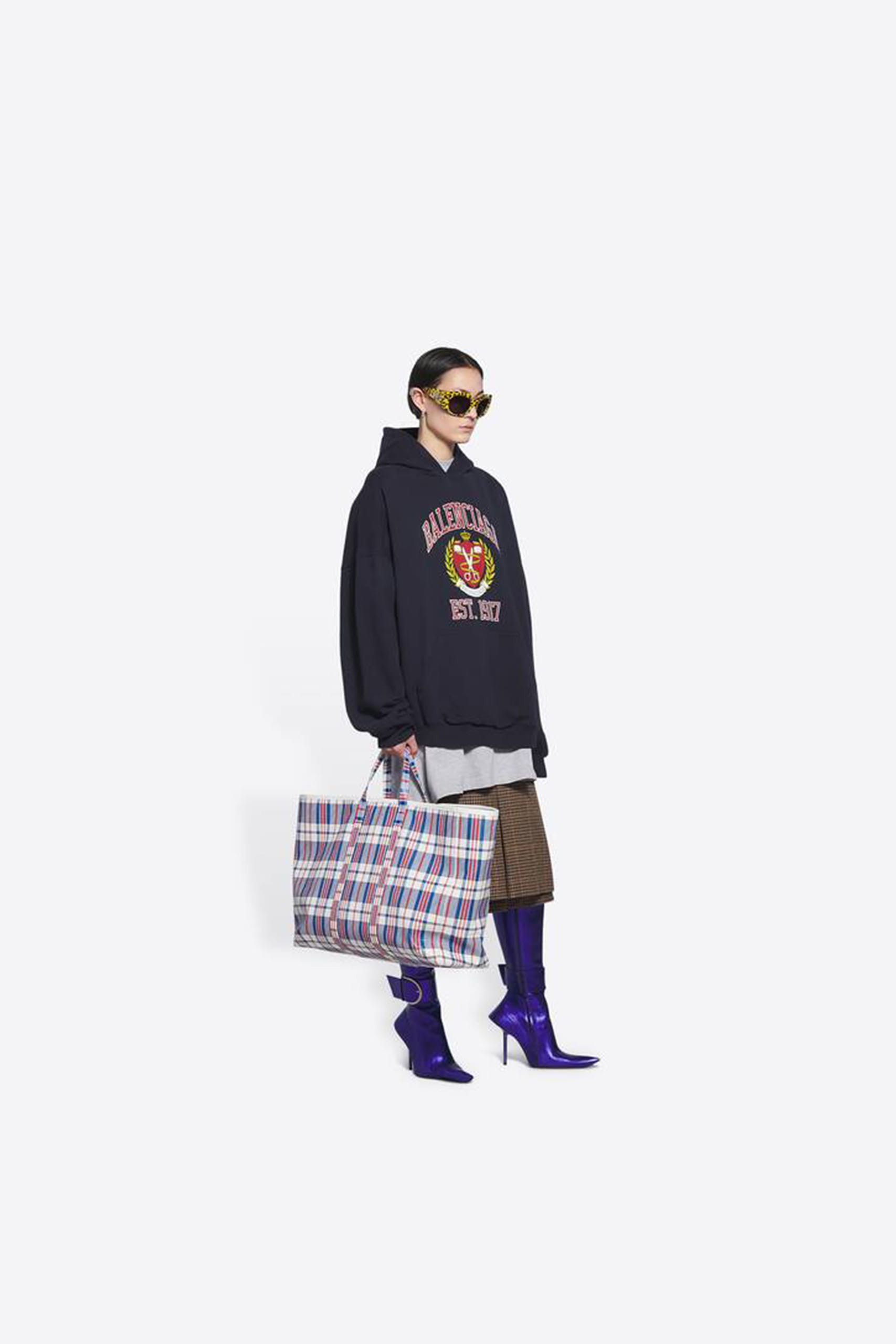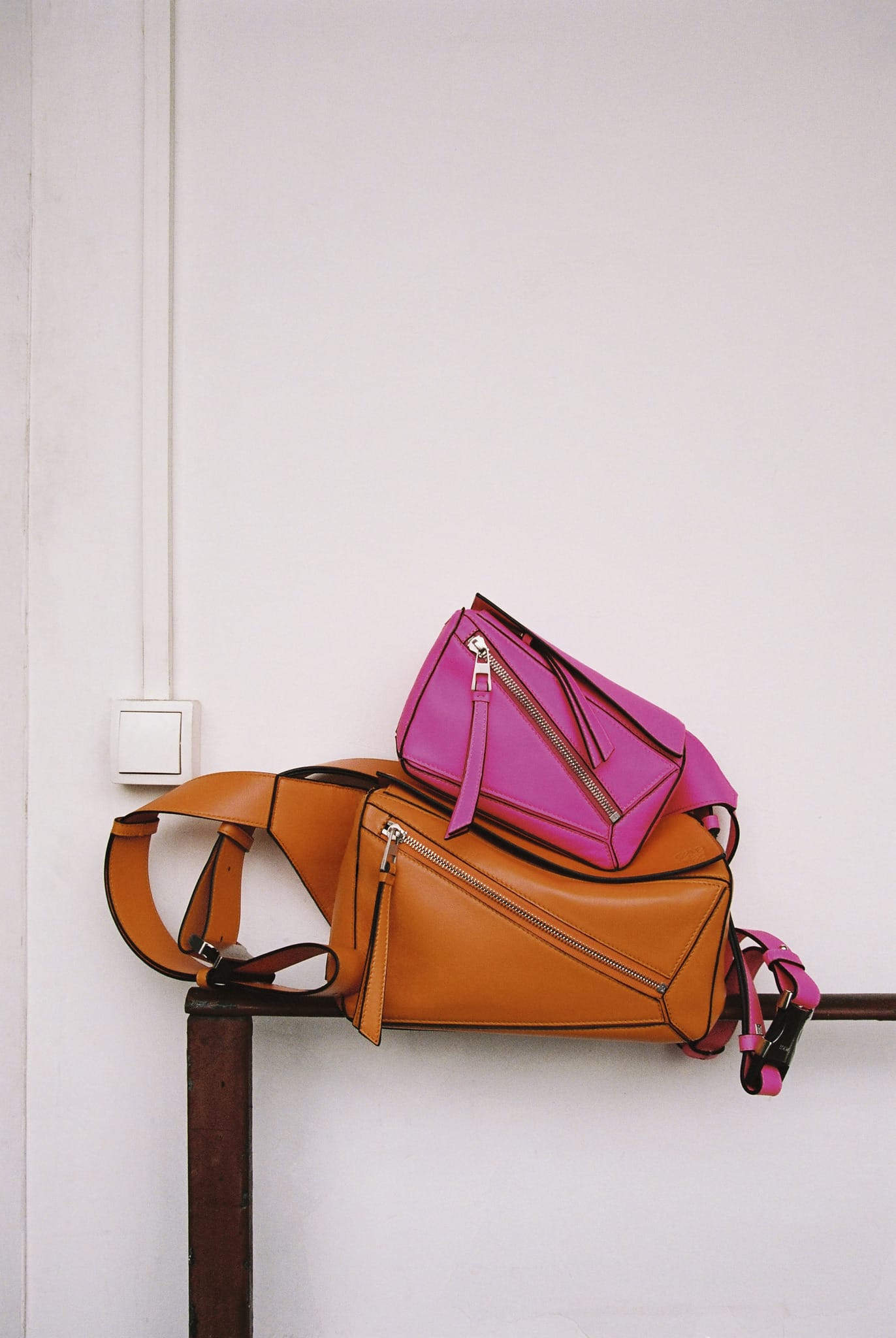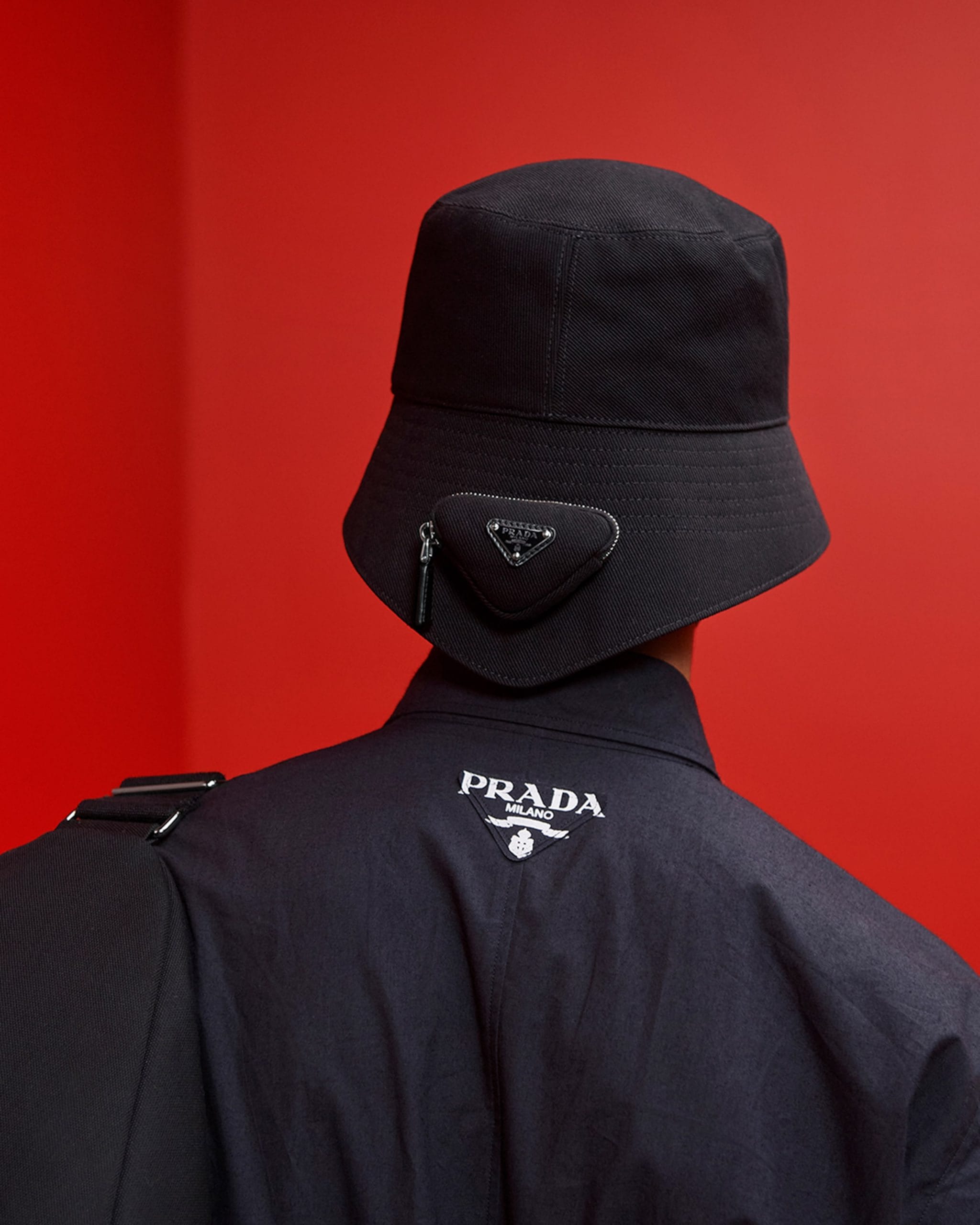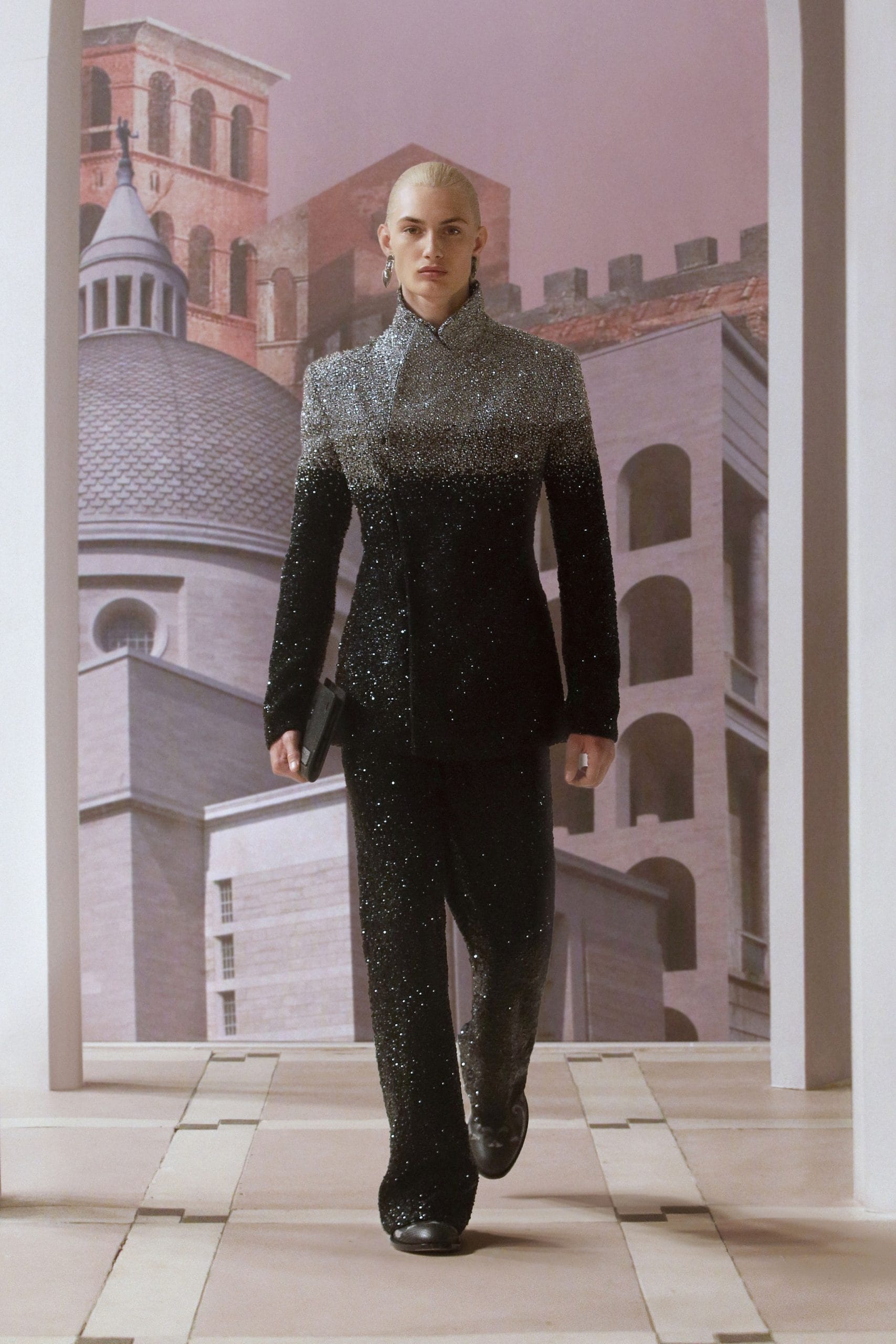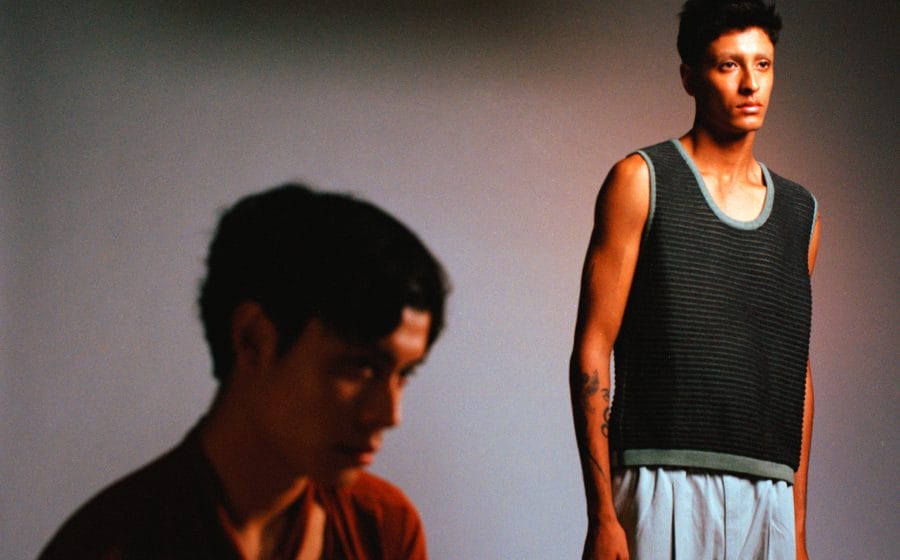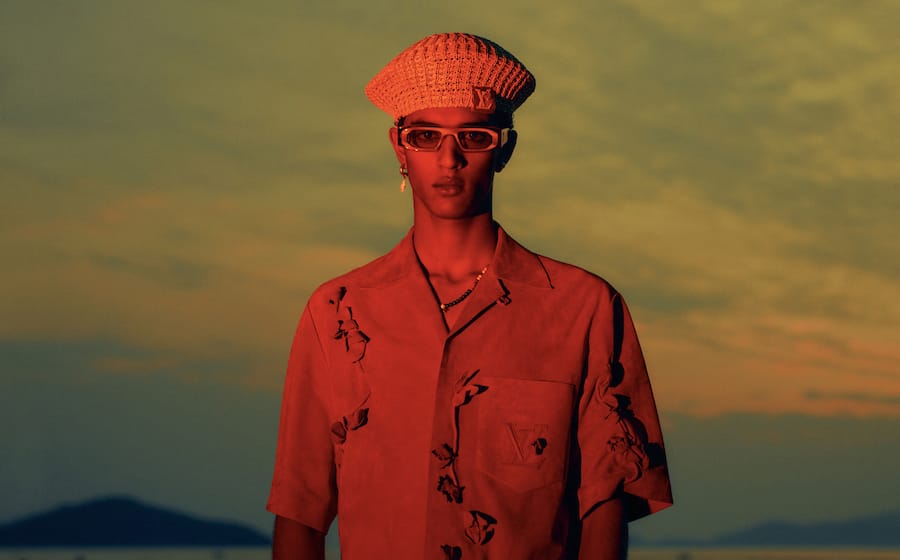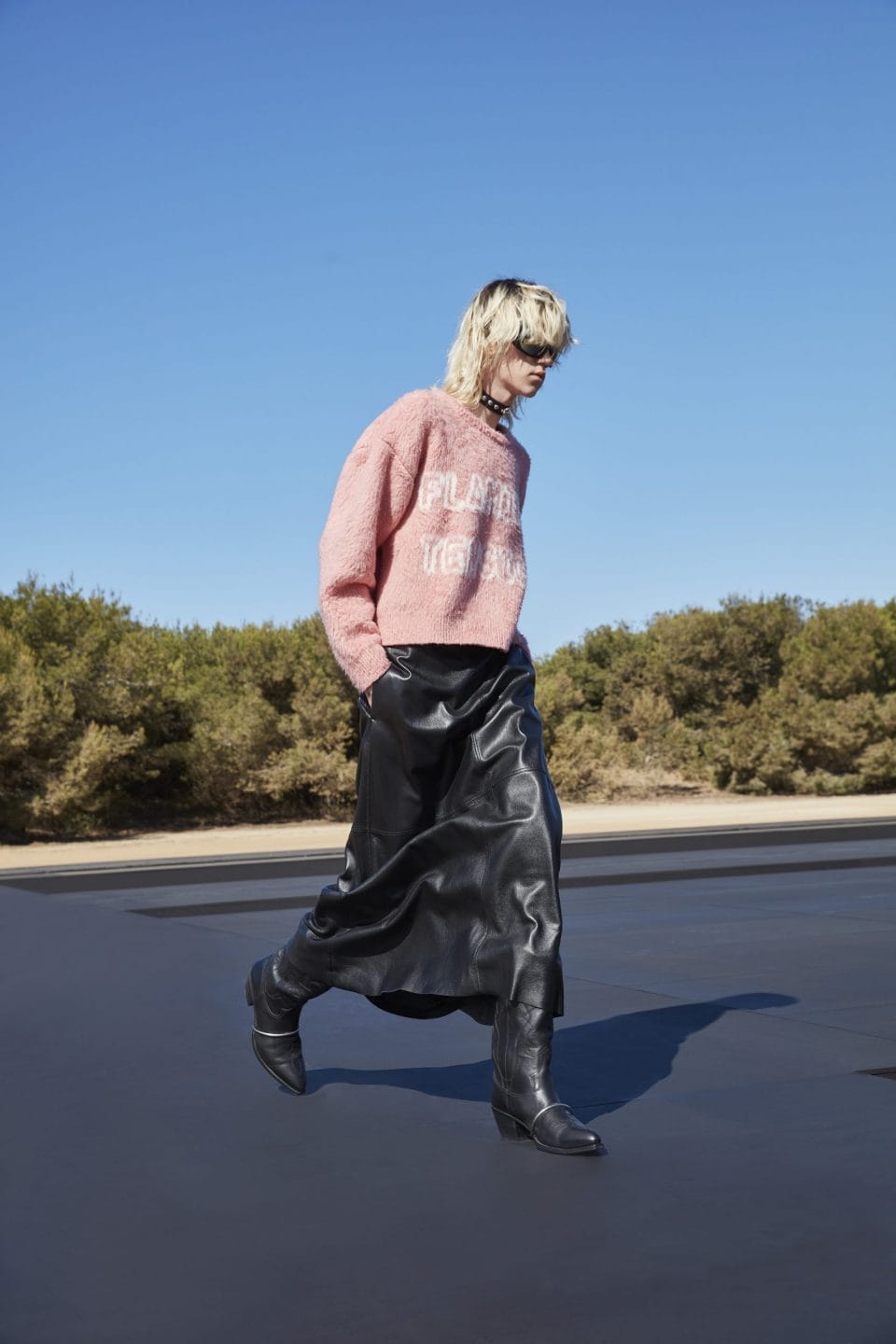
Across the menswear Spring/Summer ’22 season, designers have explored how our future relationships with dress has evolved as it attempts to indulge in a new, still undefined cultural era poised by abrupt changes as a result of the pandemic — which poses the question: what is fashion’s place in our lives today?
The fashion presentations are a visible expression of social identity. Pieces of fabrics stitched, materialised for a particular function and eventually absorbed into someone’s life — the historical insistence on this pillar displays various critical economic, social, and cultural moments in our history. Few examples support this theory; corsets were abandoned with the invention of bicycles, the dissemination of the female contraceptive birth control pill gave rise to the mini skirt, and the Vietnam War progressed fashion decades ahead.
What belies this totalising reality are moments of crisis where the same indicators became less immediate. The experience of a recession in 1991 was thought to bring back Depression-era sensibilities, where scarcity of wealth meant less excess and more purposeful choices. Instead, a newly formed desire for conceptual and famously fabulous clothes rose to popularity by the likes of designers in the UK challenging the practice of fashion and its intentions. This is where the history lesson ends and post-modern counter-culture begins — a phenomenon that still applies as we weather the pandemic more than two years in.
Culture is immediate, and in the last season, we discussed the collective and new inexplicable surge of hedonism melding across menswear brands as they set on a new future. Presentations, print advertising, and celebrity endorsements communicated one singular message: escapism. Fall/Winter ‘21 transpired along the five stages of grief, from denial to acceptance. Its burgeoning trends — with the use of latex, neon colours, and body-contoured garments — were far from reality. While these collections streamed online, loungewear sales were at an all-time high, nightlife remained hollow and travels were still restricted. There was no indication that escapism was desirable, necessary, or came in any tangible shape or form.
A year later, a small act of disobedience in fashion was inferred as an adequate cultural reaction, especially when fear brought forth by the recession wave and inflation scare constantly surrounded the gig economy. Somehow, fashion is a form of infatuation and like most of them, we eventually moved on.
This brings us back to menswear Spring/Summer ’22, a new season in fashion just as the effects of COVID-19 have ripened, where some collections were going towards the future hallmark of post-pandemic creativity. It takes an average of 18 to 254 days to form a habit. Align those digits with the number of days that most of the world would have spent either in lockdown, isolation, or socially segregated conditions, and the graph starts to mirror. As newly formed habits become second nature after 66 days, this might suggest that the menswear Spring/Summer ‘22 collections might have been made after most of society have formed new, irreversible habits.
The menswear Spring/Summer ‘22 collections are direct counter-responses to social affairs and cultural trends. We see an absence of restraints at Fendi; creative director Silvia Venturi Fendi sensibly rejects her family’s house codes and resorted to queering men’s tailoring, exposing abdomens with cropped suits and thigh-high shorts. From a consumer’s standpoint, it might be the DIY outfits trending on social media apps such as TikTok — a popular entity as an eventual result of lockdown boredom, the rise of thrift culture, and fought through with the increased social awareness of queer fashion.
Or it was Prada, which co-creative directors Miuccia Prada and Raf Simons declared that notions of the every day, its moods, and characteristics, are more desirable than the tangible. This thought incited the menswear norm of suits and crisp white shirts as the ‘illegitimate’ with trendy low-rise pants. ‘In The Mood For Prada’ — a performative message as its advertising campaign yields — Prada crosses the threshold for what fashion can provide during an emergency by asking us to, finally, be ourselves. This echoes how the discipline of creation should now answer to our insatiable desire for new things, forgoing the dependency of dress as an experience.
Are we likely to go beyond the pandemic narrative, especially as formed tastes and new habits stemmed from, politics, identity, body, culture, history, wealth, design, and the environment have spearheaded menswear to work in unthinkable ways in just a short future of six months? Spring/Summer ‘22 steers a new line that emphasises the inclusive potential of fashion. In many ways, the industry is finally righting the wrongs. This season’s counter-response ultimately depends on the people, as we continue to work against fashion stereotypes. The phenomenon for change, the same as the ones we saw in the 1990s, has finally revealed itself again. The fashion industry knows this, and as it becomes increasingly self-aware post-pandemic, the work focuses less on the form. Instead, it raises attention to social functions and thus a collective longing for real connections to clothes emerges.
What will this era in fashion say about how we live today?
Identity: The First Instance of “Un-Fashioning”
Designers have long romanced with the theatrics of gender for as long as fashioning has existed. Gentlemen were once gussied up in dresses. The love affair of well-pumped heels is believed to have been popularised by King Louis XIV during the 1600s until it became the unwritten vocabulary of the modern feminine identity, while men opted for the sartorial. As fashion became more sensible as it evolved, it was not until the last century that the exchange of gendered clothing stirred avant-garde modes of dress.
Chanel adapted jerseys from men’s underwear and freed women of restrictive fashion, disobeying the strict rules enthralled by male designers who together fetishised the misogyny of the feminine appeal. It was Phoebe Philo who saturated the industry with a legion of oversized, trendless garments as a staple in the wardrobe of women today. Yet it was the topic of men in women’s clothes, enhanced by celebrity culture in the last year, that has welcomed the return of eccentricity to the men’s wardrobe. Spot the trend now?
Fashion is not about clothes, at least not today. We can achieve ‘un-gendering’ for menswear not only through postmodern cultural context but also with alternative rebellion to create ‘newness’. This is exemplified through Kid Cudi’s stunt during his Saturday Night Live performance in April 2021 — an act he later clarified as a tribute to Kurt Cobain’s liberal, pro-feminist cover for The Face in 1993. His rebellion through fashion is a performance of Grunge, and should not be mistaken as Punk — the difference is that Grunge is not anti-fashion, it is about unfashioning, whereas Punk was anti-fashion and made statements, but Grunge is ultimately about not making any statements at all.
When it came to menswear Spring/Summer ’22, we see the same mode of un-fashioning littered across the catwalks, as it applies more accurately than simply using gender as touchpoints the way Chanel did. Hedi Slimane paired tulle skirts over biker jeans for Celine Homme, sequin cocktail dresses were spotted in their entirety at Loewe, and Virgil Abloh spared us from the excruciatingly dull by re-emphasising the skirt as a menswear staple at Louis Vuitton.
History: When Archives Tell A Different Story
Gender is a broad spectrum and even more so when it is applied to menswear. There are many case studies like Chanel and Philo that engage in acts of gendering — some subtle and others as spectacles beyond belief, the latter category raised questions of gender as today’s popular culture attempts to tell a story greater than fabrics. When is a skirt more than a skirt? Perhaps when Harry Styles supposedly ‘broke the internet’ by wearing one in the December 2020 issue of American Vogue? If it does not deter from the original intention of using ideas originally reserved for women on men’s fashion.
There are many new instances in Spring/Summer ’22 frolicking with the same trend of womenswear techniques in menswear clothing, with none more innovative or peering into the future than the designers utilising its strict womenswear archive as the foundation. Thanks to the quick wit of Anthony Vaccarello, whose Spring/Summer ’22 collection synthesises Yves Saint Laurent designs on his male subjects, whereas Kim Jones offered a similar outlook at Dior Men as he referenced the creations of Christian Dior.
Body: Sex Positivity From A Sex Positive Generation
Our liberal outlooks have embraced a wide and new set of norms — OnlyFans being one example of a breakout phenomenon. Since the early 2000s, sex-positivity has continued to inch closer into mainstream consciousness. Social justice plays a part in reimagining our relationships with bodies. It was not until the advent of social media that the conversation granted more accessibility into our everyday lives. Today, sex positivity has come to be inclusive of all sorts of sexuality.
Fashion is no stranger to sex positivity but its approach since the pandemic contrasts the origins, the very idea that ‘sex sells’ has fallen out of favour and now we need to focus on these discussions with criticality and education. There is no more room for the non-consensual glorification and sexualisation of the femme and queer body. Menswear Spring/Summer ’22 highlights our disposition for sex in the form of palatable, body-showing cuts that Shayne Oliver of Hood By Air once constituted on Helmut Lang’s work as “horny” in the late 1990s.
Politics: Independent Creators Setting Independent Ideals
23-year-old designer Shana Cave, perhaps more than any other designer working today, is nailing the art of independent creation with her complex line of niche, inquisitive ideations in the realms of bespoke jewellery. Her Instagram page (@shanacave) flexes her newfound celebrity association with her candy-like, floral designs — Bella Hadid and Dua Lipa are two of many patrons of her works. She is an example of new, uninhibited energy injected into the spectrum of fashion.
As fashion continues to remain in an extraordinary state of flux, independent creators have become more in demand. For that, in a nutshell, is the lure of fashion’s new political body that speaks to our innate desire for something exclusive when it comes to menswear; our longing to shed our own mundane, trading the value of luxury from the excess for distinct quality, craftsmanship and the future. It is full of promise and attracts praise — APOC store (@apocstore), a British independent retailer focused on young, up-and-rising designers with a made-to-order model has been increasingly in the spotlight.
Singapore-born, New York-based Taiwanese designer Shawna Wu (@shawnawux) has worked on the very same model for years and has finally found a place in fashion’s vast limelight, with pop icons such as Charli XCX sporting her goods. Luxury houses are expected to work just as hard, and have assigned this very independence in its routine; from Sacai’s successful collaboration with Dior Men to the thunderbolt transformation of Givenchy through the eyes of Alyx’s founder Matthew Williams.
Design: Seeing Beauty In Everyday Things
Design starts with an idea, a solution, and a response — it gives context to the work of designers. Some, like Raf Simons, choose to seduce with anarchical themes. His position for his eponymous label has since been rooted in mimicking the rebellious male teenage experience in its most often-repeated guise. They were vulgar for its time; bomber jackets in 2002 referenced skinheads while (to some degree) his skinny suits in 1998 defaced the gentlemen’s trope.
But 20 years since the Raf skinny suit, designers have strayed away from the overweening pride and flashy effects of fashioning solutions. The ordinary is now an exemplar of inspiration, where everyday objects now define our perception of what is considered in style. Given our current era of conscious awareness, we now have the fortunate role of acting as menswear judges and deciding the new role of beauty for the future. The pandemic quickened this evolution and enabled us to make that distinction.
The master of miscellaneous beauty was none other than Martin Margiela, who lifted the weight of custom and convention with his deconstruction of fashion via the assimilation of alternative objects.
That very presence of beauty in the unremarkable continues this season was seen at Balenciaga, Loewe, and Bottega Veneta. As writer Soetsu Yanagi proclaims in The Beauty Of Everyday Things: “What is beautiful and what is not, the advent of this new age enables us to make that distinction.”
Culture: The Seduction Of ‘Ugly”
We spent USD 49.14 billion last year getting rid of ‘ugly’ on our very bodies and faces. But the nuance of ‘ugly’ is an adjective (and a compliment) that best describes the work of Miuccia Prada. Ugly in fashion is not a new oxymoron (and particularly, in menswear) because the very act of fashion is to achieve beauty, perfection and elevation for the future. While ‘ugly’ can be used to describe anything far from a particular elevation, Prada is one of many examples where her collections are never accidentally done in bad taste.
The very aspect of what we choose to establish as ‘out’, she provokes by transforming it into the new beautiful; and establishes a new ‘in’. Ugly as luxury has since been an inescapable trend, and more so today as we exit fashion’s era of irony for the compelling. As objects of disdain from the past return as the new ‘in’ — toy necklaces, the rat-girl trope, chav-chic are some of many examples from 2021 — it becomes impossible to pass on ugly’s intellectual effects on the way we fashion ourselves today.
Environment: Replacing Plastic With Plastic
At this moment, the most crucial discussions in fashion are failing to meet their goals. Climate change, which the fashion system accelerates, has done irreparable damage to our planet. It takes 2,700 litres of water to produce a single cotton t-shirt; in a world where droughts are ever more frequent and many millions of people are denied access to safe drinking water. While we can no longer reverse the accelerating rise in sea levels, we can make profound changes by significantly cutting carbon emissions, and start making responsible choices.
This urgency has gathered designers, manufacturers, and retailers to communicate fashion with responsibility across menswear Spring/Summer ’22. Thankfully, an alternative to plastic has scored the fascination of the industry. ‘Gumboot chic’, the rubber material irreversibly tied to scenes of festivals, wet markets and protective gear, made waves across the season as viable alternatives to leather. The rubber used in houses such as Bottega Veneta and Balenciaga are biodegradable polymers that can be ‘returned’ to the earth.
The extensive use of nylon, a type of yarn derived from plastic, was swapped at Fendi and Prada for regenerated-nylon yarns; a fabric that can be recycled an indefinite number of times without affecting the quality of the material.
Wealth: Couture & Menswear
The salons of Paris once made an example of fashion innovation; each outfit contained the same amount of consideration that goes into an entire season of ready-to-wear, not forgetting that the houses that drives fashion commercially today were all built on the principle of couture. In our current climate of high inflation, massive job cuts, and a dwindle-down on fashion’s excess, how can the experimental strategies of couture continue to retain its relevancy post-pandemic?
Paris Haute Couture fashion week Fall/Winter ’21 springs this question with legacy reboots for the future and new trailblazing debuts, and tops off with looks considered for the inclusion of menswear clients. If couture is about the clothes and the clients, then there was plenty there for them to appreciate.
Demna proposed a return to the most unabashedly beautiful form of fashion there ever was, with Balenciaga’s debut Haute Couture show in modern times. The salon show replicating the authenticity of a still 1960s showroom presentation opened with a distinct, and perhaps bold, couture idea — a plain, boxy, tailored evening suit absent of opalescent details. Demna’s tuned normcore stance at Balenciaga was elevated to literal couture status; cocooning, satin, embroideries, and a bride-as-finale.
A quick Google search of the topic would see the first instance where couture — and its new adjectives and future tenses — being heavily used was during the presentation of menswear Spring Summer ‘20.
Artistic director of Dior Men, Kim Jones presented his first instance of utilising Couture techniques borrowed from the history of the House in the collection’s development process. Perhaps it is notable to also mention John Galliano as well, who rolled out an “artisanal” branch of the Maison Margiela House. While it was not officially a couture collection, it was a triumphant effort for menswear. The distinct arc, moving with queer-centred ideas of dressing and styled with impeccable deconstruction ideas through territories never-before explored helped move this return of the peacock menswear effect.
In the sudden and prolonged removal of fashion fanfare and the future, the new work produced in a menswear context was distinctively beat-less, ambient and distracted. Forms of dressmaking succumbed to numbing inertia, with each collection necessarily setting a dull tone.
It comes as no surprise that the Haute Couture collections that set the new future tone for a post-pandemic fashion generation would see the inclusion of menswear within the line-up — as with Fendi and Valentino. Each inclusion is purposeful and gimmick-free, with clear indications of what separates Haute Couture from ready-to-wear. One only needs to look at the sole idea of creating a garment, made-to-measure, lined with details that paramount any techniques compromised for collections made in mass.
The details in the crystal embroidered suit that closed the collection at Fendi cements this strong perceived idea of the potential of this new-found market within the industry. With no more than one piece made for each customer, it is a valuable resource for the inflating number of clients who would much prefer Haute Couture rather than ready-to-wear. Couture therefore ends not with a bang, but with a whisper — indicating new successions will play out a triumphant overture for menswear’s timely revival.
Once you’re done with this story about menswear’s new future, click here to catch up with our March 2022 issue!

